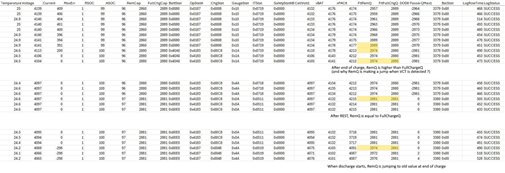Hello,
We are working with BQ40Z50-R5 gauge, and we are trying to optimize it for a new battery. There is one problem we are facing:
When we start discharging, the RSOC will stay at 100% for a long time because RemQ is higher than FCC. What I don't understand, is that after charge, passed charge is 2980mAh, but FCC will only be updated to 2880, so 100mAh less. After battery rest, RemQ is lowered to FCC value, and when we start discharge, RemQ will take the higher value back:

I tried running a few cycles (with 100% RA change allowed) to make sure RA tables and Qmax are updated, but the behavior is still the same. Temperature during charge and discharge cycles is only varying a few degrees. You can find the config file here : bmon.gg.csv
Is it expected the FCC is not increasing more ? And can you help us avoid RSOC staying at 100% for a long time ?
Thank you in advance for your help.
Vincent Praplan

